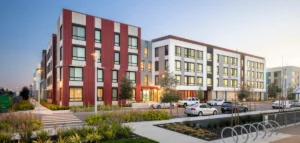While rent collections continue to slow as the coronavirus pandemic persists, multifamily may prove to be the most stable real estate investment asset in the COVID-19 downturn, according to one industry participant.
Evan Blau, a partner at New York law firm Cassin & Cassin LLP, thinks multifamily will continue to perform well no matter which way the national economy turns. If the economy rebounds, multifamily will rise as well. But if it doesn’t, government interventions such as the forbearance programs offered by mortgage agencies Fannie Mae and Freddie Mac will keep the wolf from the door, Blau believes.
Blau, who heads the firm’s Agency Lending and Affordable Housing practice and represents lenders using Fannie and Freddie’s multifamily products, recalls that when Coronavirus pandemic struck early this year, the market hit the panic button over the prospect of collections drying up. Now, though, he says there’s no dramatic dysfunction in collections.
Blau’s practice group consists of 20 lawyers, including a new hire focused on Federal Housing Administration transactions. The group is on track to close more than 1,000 Freddie and Fannie loans this year.
November’s National Multifamily Housing Council’s numbers showed full or partial collections above 80 percent through Nov. 6, a 1.1 percent increase from the same time period last year and a 1 percent increase from the same time period last month. And previous months have held up as well. “You haven’t seen this off-the-cliff moment the world is bracing for in rent collections,” Blau claims.
A look at the Rent Tracker report backs Blau’s assertion that rent payments have not contracted much year-over-year. In fact, in an early October report, they are dead even year-to-year.
A second stimulus package—which is still on hold for negotiations, especially now that the presidential election has passed—probably will call for the continuation of rental forbearance and government eviction prohibitions.
That, coupled with unemployment below 8 percent, should help buck up multifamily, says Blau, who classifies himself as “an optimist” and thinks the warring parties “will throw out politics” if the American people need the help of another stimulus. “Washington will do the right thing.”
“If things do get drastic, I think we will have a similar government intervention,” he says, calling the current 1- to 2-percent slip in collections from last year “a glass half full. What we’ve seen so far isn’t so bad.”
As others have noted, Blau mentions the movement away working in urban centers, with the result that net rent collections are likely to decline in cities. But he believes jobs will be coming back to their original offices in the next 12-18 months, and that “New York will always be New York and major cities will always be major cities.”
Blau thinks multifamily will prove to be a stable investment going forward compared to such sectors as retail or hotels, which he calls “distressed asset classes.”
The stock markets go up one day and down the next, he says, “but people always need a place to live.” And with “very cheap money at low interest rates,” he sees a favorable playing field for multifamily developers and investors. He sees rates staying low “for the foreseeable future.”
Freddie and Fannie in particular have acted “heroically in a time of economic uncertainty,” he claims, both with their forbearance policies and by providing liquidity and access to capital to both the single-family and multifamily sectors. “They continue to lend money when private money has exited,” he says.
“Fannie and Freddie will continue to play a dominant role, even post-COVID,” he feels, giving the agencies a grade of A-plus.
Affordable housing also is a net plus for the multifamily market, he says, both in urban and rural markets. “As long as there is a housing shortage and a need for affordable housing, the government agencies will find ways to build affordable housing,” he says.
The National Council of State Housing Agencies agrees with Blau that federal intervention is needed, and the group has some dramatic figures to back up their argument.
U.S. renters “will owe up to $34 billion in past-due rent by January,” according to a new NCSHA report. That’s when a Center for Disease Control’s nationwide eviction moratorium ends.
As of Sept. 17, between 10 and 14 million renters owed between $12-17 billion in back rent. More than eight million renter households face eviction come January if they are three months or more behind on what they owe, NCSHA says.
Breaking it down by state, NCSHA estimates 640,000 households in Florida could be turned out of their homes, along with nearly a quarter million each in Michigan, North Carolina and Pennsylvania.
The group cited a recent National Apartment Association release on the financial impact of such an eviction wave, saying it could result in:
- $6.8 billion to $9.2 billion in reduced apartment payroll expenses
- $3.5 billion to $4.8 billion in cuts to local property tax revenue to fund teachers, police, firefighters, and other personnel.
- $2.5 billion to $3.4 billion in deferred maintenance and delayed repairs necessary to maintain health and safety for renters.
Landlords of color will be feeling the pain more than others, according to the Urban Institute.
“Black and Hispanic landlords are struggling to pay their mortgages more than white landlords and are more apt to take mortgage forbearance,” according to Urban Institute’s Laurie Goodman and Jung Hyun Cloi.
Yet, despite their struggles, Black and Hispanic landlords are more likely to offer their tenants a rent payment plan, suggesting these landlords are dedicated to keeping their tenants, she and Choi point out. Black and Hispanic landlords are likely to make less income than their White counterparts and are more likely to own just one property and have a mortgage on it.
“There is a 10 percentage-point gap between the shares of White and Black landlords with incomes below $75,000 and a slightly smaller gap between White and Hispanic landlords. Nearly half of Hispanic landlords own only one property and 40 percent of Black landlords own only one property (versus 32 percent of White landlords). White landlords have five or more properties more often as well,” they said in a recent report.
About 20 percent of Black landlords, 14 percent of Hispanic landlords, and 9 percent of white landlords have at least one mortgage in forbearance.
According to a survey of 2,225 landlords, 42 percent of black landlords and 48 percent of Hispanic landlords offered rent payment plans to their tenants, compared to 36 percent by white landlords. But those renters are still on the hook for eventual payments, as not many of the landlords forgave rent outright, the Goodman and Choi said.
SOURCE: Multi-Housing News












